We love to dive in Bonaire. Once geared up and off the end of the dive boat, immersion into a more peaceful and wondrous world is absolute. We are immediately surrounded by the beauty of hundreds of unique coral shapes on both the ocean floor and “walls”, a multitude of fish and marine life both large and small, and all come together in a rainbow of color. Being on the Douglas Spring Trail in the Saguaro National Park in Arizona reminded Chuck of diving. Instead of coral and fish, we had rock formations, flowers, butterflies, cacti, and birds…in a desert no less!
The Saguaro Cactus, which this park was established to protect, adds character to the landscape.
Rarely has the beauty of an area moved me to tears as this one did- Chuck takes me to the nicest places. We added three new species to our list here, one of which was the Phainopepla who seemed to look at us with disdain for our lack of ability to call this marvelous place home.
We visited both the Big Bend National Park in Texas and the Saguaro National Park AZ, while in bloom, but the two desert environments were strikingly different. The Big Bend has a tremendous variety of plant life ranging across the 800,000 acre park, but plants were overwhelmed by the geological structure and sweeping vistas. The Saguaro at 90,000 acres has its plant life adding structure to the mountains and since the flowers and cacti are spaced more densely it creates an intensity not felt at Big Bend.
Both were beautiful in their own right.
We camped at the Kartchner Caverns State Park, AZ as our home base for 4 nights, and found 3 new birds on the first and only day that we birded the park’s nature trail; it was here that we saw our first Green-tailed Towhee.
Kartchner Caverns is an exemplary campground, with the focal point of the park being the world renowned living caverns, which I am embarrassed to say, we did not make time for. We are scheduled to be birding this area again in April and have already booked our cavern tour!
The Ramsey Canyon Preserve, a Nature Conservancy site, is well known in large part for their Hummingbirds. Our reconnaissance mission brought us here too early for hummers, but we did locate three new birds. We could feel the dramatic difference between the moist canyon and dry desert around us, and enjoyed yet another lunch next to a gurgling creek… it sure is hard to get bored with this life.
At the San Pedro House, listed as one of the best established sites along the river, the first bird to grab our attention, mingling with a flock of Red Winged Blackbirds, was the Yellow Headed Blackbird. Our hike started in a dry desert type grassland and continued into a cottonwood riparian woodland. This proved to be a good birding area for us, even during this non-migratory time, and we found 6 species along with one more on our drive. Interestingly, we found the Louisiana Waterthrush here, which is a rarity for this area, though not a rarity at home.
It also proved to be a lucky spot- Chuck’s camera lens, the one with the Swarovski scope attachment fell off his camera unnoticed for at least 30 minutes of hiking. A frantic search ensued, but concluded with its return by a kind and honest person; she certainly set a fine example for her children and saved our “Big Year”.
Huachuca birding sites are located on the Fort Huachuca Army Base. Here we were looking for the elusive Sinola Wren, and Magnificent Trogon. Like others birding near us, we missed both, but enjoyed a lovely lunch- “The Perfect Picnic Spot” that even Poppa Berenstein Bear would envy. 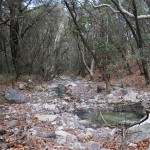 This was a lovely area to hike, but don’t use the bathrooms…
This was a lovely area to hike, but don’t use the bathrooms… 
Patagonia Lake State Park- The parks birdfeeders allowed us to enjoy watching the antics of our first Broad-billed Hummingbird, though we were able to see several on the trail as well. The birding trail started right next to our campground, with warning signs to watch for mountain lions-yikes.
We took a lunch break from birding at a picnic table overlooking the lake and had our first Plumbeous Vireo as well as this saucy little Northern Beardless-Tyrannulet who joined us. The campground was well laid out and maintained, and we have already booked our return.
Patagonia-Sonoita Creek Preserve is a Sister site to the Nature Conservancy’s Ramsey Canyon. This site had busy hummingbird feeders, allowing us to see the Broad-billed humming bird again, as well as our first looks at the Rufous and Anna’s hummingbirds. We had been hoping to see an Abert’s Towhee for the last few days, and here a couple of them made themselves well known to us. They are typically secretive staying under brush, but this pair gave us good looks although not good pictures. From here, we went just a short distance to Paton’s Yard- A Yard with history. In the 70’s the Paton’s, who owned the modest home near the preserve, found a Violet-crowned Hummingbird at their feeder creating a birdwatchers stir, and they welcomed birdwatchers to their yard from then on. The site was turned over to the Tucson Audubon Society at their death. Birding here was sparse in this off season, but will hopefully live up to its reputation when we return in April.
Another of the famous birding sites in Arizona, the Madera Canyon of the Santa Rita Mountains, is in located in the Coronado National Forest, and is expected to be hopping when the migration starts. We decided to try the ‘road less traveled’ to get here- a twisting forest service road, where no two vehicles should ever meet, and based on the sign…may not be ‘less traveled’.  There were an abundance of birds along this route, but Chuck couldn’t take his eyes off the road. We didn’t see any smugglers or illegal immigration activity! Since this was our exploratory visit to the Canyon, we chose an enjoyable but rather strenuous 9 mile mountain hike as opposed to the classic birding areas, and it was well worth it. Here we found three new birds, including this Townsends Solitaire,
There were an abundance of birds along this route, but Chuck couldn’t take his eyes off the road. We didn’t see any smugglers or illegal immigration activity! Since this was our exploratory visit to the Canyon, we chose an enjoyable but rather strenuous 9 mile mountain hike as opposed to the classic birding areas, and it was well worth it. Here we found three new birds, including this Townsends Solitaire,
which we thought would be more challenging to tell from the Northern Mockingbird, but the distinctive white eye-ring made identification easy. We were also able to appreciate the Madera Canyon itself, as one of Arizona’s “Sky Island” desert oases, in the Santa Rita Mountains. Sky Islands are mountains that isolate the plants and animals above the desert. Moving up the mountain from the base, some 7000 feet, there is a distinct difference in plant and animal life due to the temperature decrease and moisture increase. Typical desert plants and grasses, transition to the unique Alligator Juniper, to Ponderosa pine and Maples, and then to Douglas firs. The Sky Island Alliance states that bird diversity here includes over half of the North American bird species. We didn’t see quite that many… but we will be back!
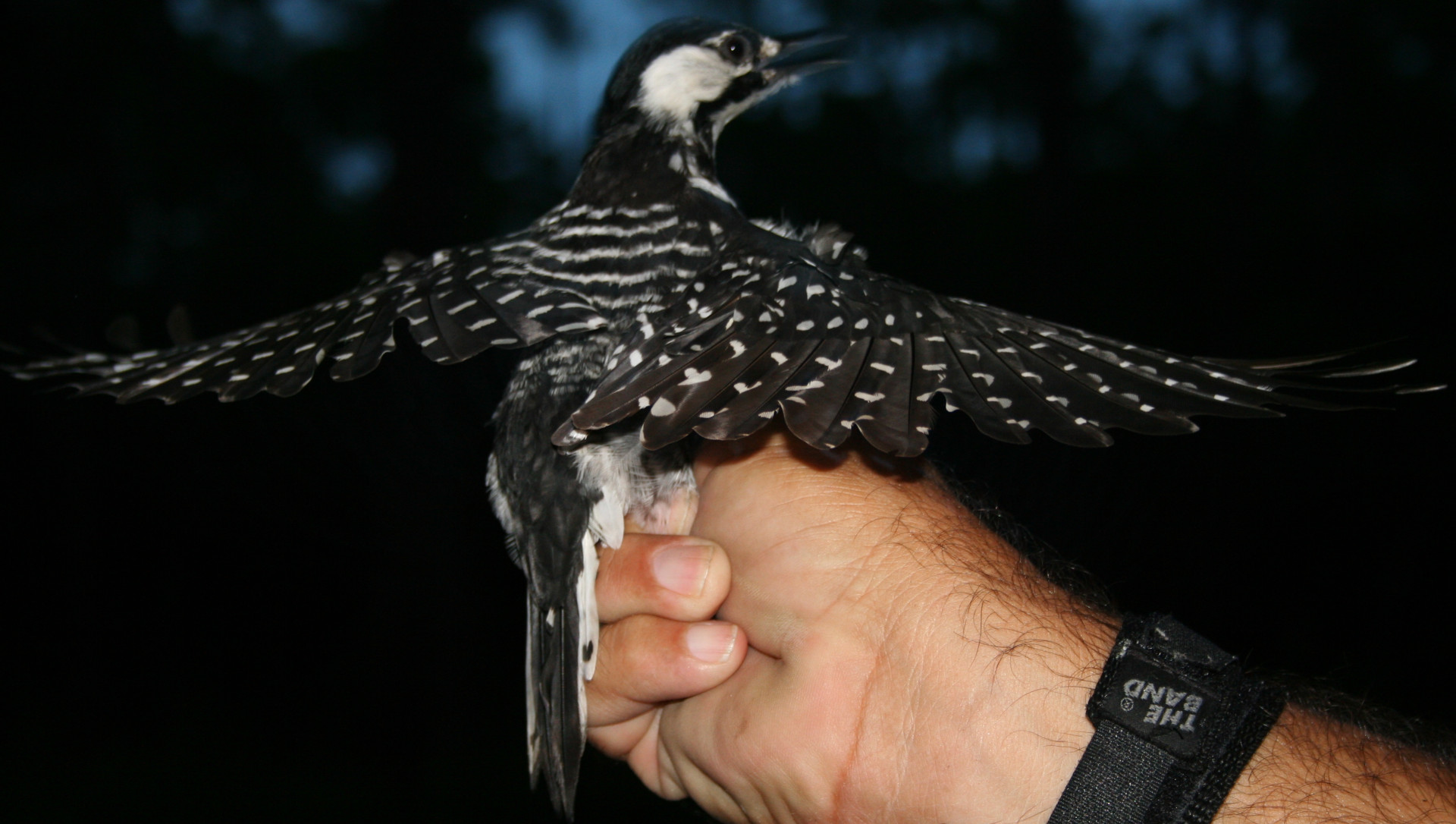
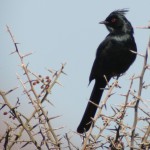
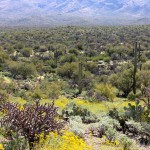
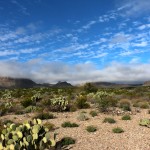
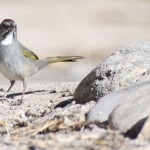

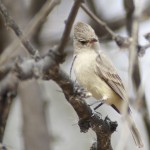
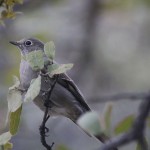
Very entertaining (and educational) narrative, as always, Carrie, and Chuck’s photos are just marvelous (I love the phainopepla)! Thanks for keeping us “in the loop”… so glad you’re living the dream! 🙂 C&T